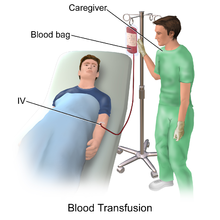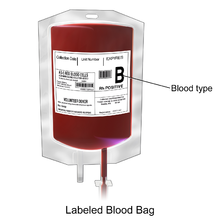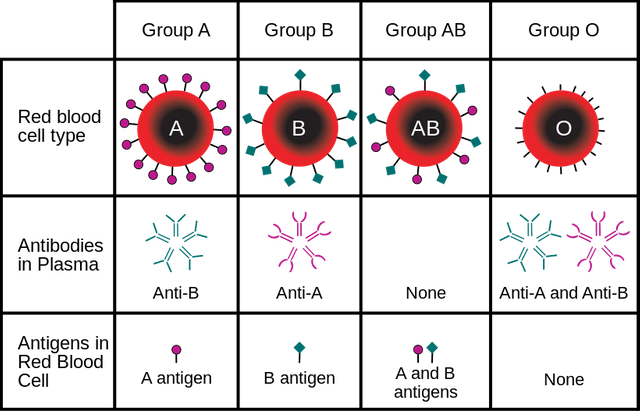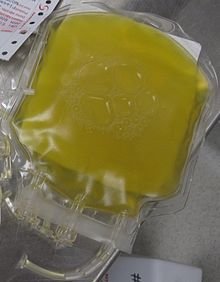BLOOD TRANSFUSION REACTIONS(the secret behind patients death)

illustration depicting intravenous blood transfusionwikimedia- CC BY-SA 3.0
Patient:
good morning doctor
Doctor:
good morning dear, what can i do for you
Patient:
i came to collect my test result and to know what i am actually suffering from.
Doctor:
The test result indicates that you have coronary artery disease which prevents blood from flowing normally into your heart. This is as a result of blockage in your artery and it must be remove through surgical operation. I advise you donate blood now that will be use for the surgery in three months time.
Patient:
please doctor i dont think i can be able to do so,it is better i order for blood or i call for who will donate for me
Doctor:
donating blood for yourself is very much important in order to avoid any transfusion reactions which may arise as a result of another persons blood. Let me explain to you what you must know about transfusion reactions.
In the history of blood donation, transfusion reactions has been the major problem in donating blood for people.
Blood where transfused then without proper screening of the blood which might actually lead to transfusion reactions. Because of the risk factors involved in blood transfusion medical practitioners have putting great efforts to see that the rate of reactions are minimized.
Blood transfusion simply means giving out blood to maintain or sustain life. Blood mostly are giving to those who is anaemic or people who had an accident that has already lost a great quantity of blood.
Blood that are meant to be giving out must be properly screened in other to make sure that the blood is free from different diseases. According to world health health organization
all donated blood should be tested for transfusion transmissible infections, these include, HIV,hepatitis B,hepatitis C,treponema pallidum and other infections.
Blood transfusion can actually be splited into two types, autologous and allogeneic type. Autologous transfusion which can equally be called self donation, are blood donated for self purposes. This normally happens when a patients is preparing for an operation, he/she are adviced to donate blood three or four months prior to the operation date. This is done in other to help the patients out from any complication that may result from another blood.
Allogeneic blood transfusion is the act of donating blood for another individual, this transfusion usually carries a lot of complications which might be as a result of incompatility between the two blood. This type of blood donation is the major reason why a blood must be screened from infections before donation.
Blood donation
In blood donation many factors are considered in other to make sure that a transfused blood does not react with the patients own blood.
 illustration of labelled blood bag.source:wikimedia- CC BY-SA 3.0
illustration of labelled blood bag.source:wikimedia- CC BY-SA 3.0 Blood are collected in the CPDA bag(citrate phostrate dextrose adenine). This bag contains a special anticoagulant that prevent the blood from clothing. It is a 450ml blood bag that contains 63ml of anticoagulant.
This anticoagulant prevents clotting of the blood by maintaining its fluidic nature.
Blood are then collected from the patient and kept aside for further screening test like checking the patients blood group and checking for the compatibility of the blood in other to make sure that the blood is entirely free from infections.
Blood grouping/compatibility
Blood grouping is done to determine the antigen of the patient.
 illustration of ABO blood antigenwikimedia- CC BY-SA 3.0
illustration of ABO blood antigenwikimedia- CC BY-SA 3.0 It is done to check if the patient is in A,B,AB and O group. It is done by using antiserum to determine the group. Addition of two drops of blood in the tile and an equivalent antiserum. The tile is checked and agglutination is detected.
Compatibility testing is done to check if the two blood are compatible. This involves testing the donors red cells against the recipient serum to confirm both the patients and the donors ABO and rhesus blood group, it is also use to check for complete and incomplete antibodies in plasma of the recipient.It involves four different test,a saline test at room temperature, albumin test at 37°C,a saline at 37°C and antiglobulin test which also serve as a confirmatory test for all the three methods.
Haven't considered this, transfusion reactions has also caused a lot of damages which has cost many life's. Another critical example is in hemolytic disease of the newborn. Where a rhesus negative mother is carrying a rhesus positive child. During delivery, the blood of the child terms to sensitise the mother's blood which lead to the production of IgG antibody against the child's antigen. The first delivery may not actually affect the child but subsequent one will cause a lot of damages leading to still birth.
Transfusion reactions are grouped into two types which are immune and non immune.
non immune transfusion reactions are the reactions that does not involves the immune system, this may be as a result of defects in the blood components. they are massive transfusion, transfusion of infections, air embolism and transfusion hemosiderosis.
Non immune transfusion reactions
Massive transfusion: this reactions takes place when there is excess transfusion of blood above normal blood volume, this can results to coagulation factor dilution.
Transmission of infection: many diseases can be giving or transfused to a patient if a blood is not proper screened.these include hepatitis, syphilis,toxoplasmosis, HIV and many others.
Air embolism: this can occur if there are presence of air in the circulation, but this is no longer obtainable as blood bags are now well designed.
Transfusion hemosiderosis: this is a major factor in blood transfusion. Normally blood contains iron. When blood is giving in large quantity, there is always excess iron in the blood which leads to myocardial infarction, kidney and liver damage.
Immune transfusion reaction
Acute hemolytic transfusion reactions; this is an ABO incompatibility. This is cause as a result of increase in antigen titre of the blood, which leads to agglutination by the antibody of the recipient.
 a bag containing one unit of fresh frozen plasma wikimedia- CC BY-SA 3.0
a bag containing one unit of fresh frozen plasma wikimedia- CC BY-SA 3.0 This antigen-antibody complex results to the secretion of many factors in the body. There is activation of coagulation factor and bradykinin. There will also be release of cytokines which produces tumor necrotic factor,lL-1B,lL-6 and lL-8. Apart from these,antibody also fix complement which causes red blood cell lysis.
Secretion of bradykinin leads to severe hypotention,also secretion of tumor necrotic factor lead to increase in nitride oxide which causes vasodilation of the vessel,it also cause decrease in thrombomodulin level,secretion of C3a/C5a causes increase in histamine release and leukotriene. There will also be a release of the HGB into circulation.
The production of all these substances may leads to abnormal changes.
in incompatible, cytokines secreted,promotes fever,why haemoglobin free RBC stroma damages the kidney. Laboratory findings are haemoglobinaemia,hemoglobinuria, hyperbilirubinaemia,low hypotension, and positive direct antiglobulin test.
Treatment of this disorder is by management of those diseases that arises, like hypotention,coagulation disorder and renal dysfunction.
Febrile non hemolytic transfusion reactions
This reactions is always associated with increase in the production of cytokines such as interleukin 1,6 and tumor necrotic factor. This excessive production leads to an increase in temperature and also causes uncontrollable fever. Production of these cytokines may either occur in the blood bag due to improper storage or occur in the body.
This occurrence in the body is as a result of increase in the leukocytes. The clinical features are fever,increased respiratory rate,changes in blood pressure, nausea and vomiting. This condition can be managed by leukoreduction and by giving antepyretic.
Transfusion related sepsis
Bacteria contamination has been the major factors that is associated with transfusion reaction. Platelet can be contaminated through the the skin. This is as a result of exposing the blood to bacteria without proper preservation.
Some of the contaminating agents include yersinia,serretia,pseudomonas species and Escherichia coli. Earlier symptoms seen in this conditions are fever,rigors,hypotension and disseminated intravascular coagulopathy. This bacteria infection can treated using antibiotics and pressure support.
Conclusion
Transfusion reactions is a devastating occurrences in the body that can cause death. It is cause as a result of blood components or body mechanism of action. Blood that are transfused to a patient must be leukoreduced if the leukocyte level is high in order to avoid agglutination reactions by the recipient antibody.
Also the storage method is also checked. If it is not properly stored there is always a release of cytokines in the blood which binds with the antibody of the recipient causing reactions that are uncontrollable.
In the side of the recipient, a recipient must be compatible with the blood he/she is meant to receive by doing crossmaching test. With all this regulations, blood transfusion reactions can be eliminated.
Refrences
1,transfusion reaction~wikipedia
2, cross matching~wikipedia
3,Antibody~wikipedia
4,blood typing~wikipedia
Hello @hillaryisidore, we would like to recommend that you join the discord server of stemng,
https://discord.gg/sareQ5N, for tips on how to write a great STEM article.
This post has been voted on by the steemstem curation team and voting trail.
There is more to SteemSTEM than just writing posts, check here for some more tips on being a community member. You can also join our discord here to get to know the rest of the community!